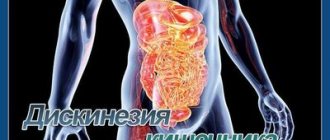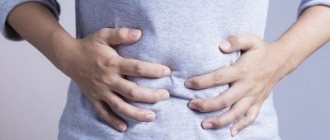Many factors can lead to symptoms such as constipation. It is possible to normalize intestinal function during constipation only by eliminating the primary disease. If this is not done, then some time after treatment, the symptom will return again. The appearance of coprostasis is indicated not by the frequency of bowel movements, but by difficulties and discomfort during bowel movements.
So, if defecation is less than once a day, but emptying does not cause discomfort or pain, and the fecal cylinder is of normal size and consistency, then there is no talk of constipation. If, during the act of defecation, you have to strain, the feces are fragmented (“sheep” feces) or the fecal cylinder is too large, then, despite the frequency of bowel movements, we can talk about a malfunction of the organ.
Coprostasis can develop due to a disruption in the process of feces formation or a deterioration in the passage of feces through the intestines, which directly depends on the motor activity of the organ, the position of the colon, the diameter of its lumen, as well as the amount of intestinal contents. Stool retention can be caused by organic or physiological pathology.
In case of organic pathology, surgical intervention is necessary, since constipation is caused by anatomical changes in the intestines. With physiological disorders, intestinal motor activity is slowed down as a result of deterioration of innervation. It is possible to improve intestinal function during constipation associated with atony through diet, exercise, taking medications and developing a reflex to defecate.
Features of intestinal motility
Peristalsis refers to reflex actions.
The normal functioning of the intestine occurs as a systematic contraction of the muscles lining the walls of this organ. The contractions are wavy in nature.
They become possible due to the peculiar structure of muscle fibers in this area. Firstly, they have a double layer.
Secondly, the direction of the muscle fibers of the upper and lower layers does not coincide, but runs perpendicular to each other. The intensity of contractions varies depending on the section of the intestine.
In the small intestine, contractions occur either quite slowly or very rapidly, depending on the situation. But in the large intestine, contractions can only be slow, because a large bolus of food moves there. However, they are also systematic. Otherwise, the chyme would not be able to reach the anus. These contractions are commonly called peristalsis.
Peristalsis refers to reflex actions. It occurs immediately after the appearance of food in the gastrointestinal tract. The average frequency of contractions in different parts of the intestine is as follows:
- duodenum - approximately 10 per minute;
- small intestine – 9 – 10 / min;
- large intestine – 3 – 4 / min;
- rectum - up to 3.
If any reasons have affected the slowdown of peristalsis, the entire body is exposed to the negative effects of the consequences. Minerals and other beneficial substances are less easily absorbed, causing problems with bowel movements.
As a result, elements of chyme that are not removed in time decompose, leading to the spread of toxins throughout the body, contributing to the development of symptoms characteristic of intestinal dyskinesia.
Creon
Most gastroenterologists recommend taking Creon, as it is available in capsule form. As mentioned above, the effectiveness of capsules is much higher, since the drug penetrates not only the stomach, but also the intestines. The main active ingredient in Creon is pancreatin, which very well stimulates the production of all necessary enzymes. It is prescribed during treatment:
- Chronic pancreatitis
- After operations performed on the gastrointestinal tract
- Cystic fibrosis
- Oncological diseases, namely tumors formed in the immediate vicinity of the stomach and pancreas, thereby interfering with their normal functioning
- Creon is also recommended to be taken during a large meal (at corporate parties, holidays, etc.) in order to improve digestion and prevent the occurrence of indigestion.
It is recommended to take one capsule before each meal. It is advisable to simply drink it with water and not chew it, so that the drug enters not only the stomach, but also the intestines. Separately, it is necessary to say about side effects. The drug does not have them as such, but as regards the reaction of the gastrointestinal tract, diarrhea may develop and pain in the stomach area will appear. Some patients develop hives. Usually this is the body’s reaction not to pancreatin, but to the auxiliary components of the medicine.
Creon is one of the drugs that can improve digestion. True, it is considered much stronger than Pancreatin, and therefore can only be taken after a doctor’s prescription.
Reasons for slower peristalsis
If bowel dysfunction occurs, surgery may be required.
Malfunctions in the intestines have their own causes. In order to completely normalize the situation, the doctor will first of all identify the reason that provoked the deterioration in well-being. In most cases there are several reasons:
- eating large amounts of high-calorie foods;
- chronic intestinal diseases;
- tumors (malignant, benign);
- surgical intervention;
- insufficient physical activity;
- taking medications that inhibit bowel function;
- old age;
- genetic predisposition.
Even with proper treatment of the underlying disease, it is impossible to regulate the functioning of the intestines without a balanced diet. Flour products, dishes containing a lot of starch, and fats have a negative effect. Sugar is a product that enhances putrefactive processes in the digestive tract.
When peristalsis slows down, toxins are formed in large quantities and enter other organs through the intestinal walls. In the intestine itself, the chyme that is not released hardens over time, and “fecal stones” are obtained. In order for them to come out naturally, the functionality of this organ must be completely restored.
It's quite difficult to push them out. After all, they are very dense and heavy. If they pass through the intestinal passages, the walls are destroyed, as a result of which dangerous diseases develop. Among them are cracks. Stagnation of blood in this organ leads to the appearance of polyps and hemorrhoids. Elderly patients have their own sequence of pathology development. Their hormonal levels change, muscle fibers become weaker and sluggish. And all existing chronic diseases progress.
The role of fiber
Dietary fiber is the basis of plant structure.
As needed by the body, this nutritional component can be supplied along with water, carbohydrates, proteins and fats. Fiber absorbs and removes harmful substances from the gastrointestinal tract. The benefit of dietary fiber is the adsorption of water. As a rule, with constipation, stool that has a hard consistency stagnates in the human body. Dietary fiber, absorbing water, becomes jelly-like, envelops and softens the solid fractions of waste food. In addition, fiber helps increase the volume of feces, the number of beneficial bacteria in the intestines, enhances the enzymatic activity of microorganisms, and facilitates bowel movements.
Foods rich in fiber activate intestinal motility. They prevent the formation of gallstones, reduce blood sugar levels, lower blood pressure and the amount of estrogen, and fight excess weight.
How to get rid of constipation with fiber?
The easiest way is to enrich your daily diet with whole grains, fresh fruits, and vegetables. Dietary fiber can be consumed separately in the form of bran. Reception begins with 2 grams, gradually increasing the dose to 40 grams (on the 14th day of the body’s adaptation to the new product). The daily portion is divided into 3–4 doses.
Exceeding the permissible dose causes side effects: gas formation, flatulence, bloating. Fiber can be mixed into main dishes or diluted in drinks (juice, kefir, yogurt, fermented baked milk) immediately before consumption.
Remember, to effectively treat constipation, you need to drink at least 2 liters of water per day. Otherwise, if there is not enough fluid in the body, fiber can cause constipation.
Acceleration of peristalsis
Sometimes the functioning of the intestines follows an accelerated pattern. Wave-like contractions occur at a faster speed than normal. This condition can be caused by oncological pathology, microflora disorders, or the development of chronic diseases. Externally, increased peristalsis is expressed in attacks of diarrhea. Diarrhea is accompanied by pain, foamy discharge, and the stool is watery.
To normalize the situation, it is necessary to be examined to accurately determine the cause of this condition. After this, you can take action. Illiterate treatment can completely destabilize the condition. If serious problems cannot be identified, then the cause is poor nutrition. After following the diet, the condition should improve. To speed up recovery. You can take medications that slow down peristalsis. These are diara, imodium and its analogue - loperamide.
Diet for constipation
This is a combination of ten fasting days, where food products that have a laxative effect and an astringent effect are changed in turn.
Day No. 1
Vegetable salad of apples, greens, cabbage, beets and carrots, dressed with olive oil.
Day No. 2
Apples, oatmeal.
Day No. 3
Prunes, low-fat cottage cheese (5%), apples.
Day No. 4
Apples baked in the oven can be added with honey.
Day No. 5
Buckwheat porridge with the addition of herbs and vegetable oil.
Day No. 6
Green peas, boiled beans, greens.
Day No. 7
Vegetarian cabbage rolls with carrots and buckwheat.
Day No. 8
Greens (dill, parsley), noodles made from coarse flour with cottage cheese.
Day No. 9
Dietary borscht (chicken fillet) with beans.
Day No. 10
Fruit and berry compote, wheat porridge.
Proper nutrition, an active lifestyle and sufficient water are the three components on which the health of the digestive system rests.
Medications that improve peristalsis
Guttalax is addictive.
To improve the functioning of the intestines, drugs are prescribed that help increase motility and muscle tone.
It could be vasopressin, proserin. But self-medication is dangerous, so you can take these drugs only after they have been prescribed by a doctor.
To improve intestinal contractions, laxatives can be used. They are divided into groups depending on which part of the intestine they affect.
- General laxatives. This group includes drugs that have a beneficial effect on all intestinal sections at once. For example. Epsom salt increases osmotic pressure, resulting in bowel movements within an hour and a half.
- Remedies for the small intestine. The classic remedy is castor oil. It facilitates the movement of the food bolus and improves motor skills. Defecation occurs after 2–5 hours. Unpleasant side effects include possible pain.
- Remedies for the large intestine. These are mainly herbal preparations, for example, buckthorn bark. The action is the ability to enhance the tone of the walls.
- Synthetic products. Guttalax and others like it are effective. However, they are dangerous because they can become addictive.
Drugs to improve digestion
Festal is one of the most popular drugs
If there is a malfunction in digestion, it can be improved only by following a diet and taking medications. All drugs can be divided into several groups, each of which differs in its main active ingredient and its effect:
- Preparations containing pancreatin as the main component. It is pancreatin that is the enzyme that can provide immediate support in case of digestive disorders. Such medications include Pancreatin, Mezim, Penzital, Creon
- Preparations that, in addition to pancreatin, contain other auxiliary components, such as hemicellulose, bile acids, etc. These components help break down complex sugar compounds, improve intestinal activity and the production of enzymes by the pancreas. The main drugs in this group include Festal, Enzistal, Panzinorm
- Drugs that help normalize the exocrine activity of the pancreas. Such drugs include Somilaza, Nigedaza, Oraza
Only a doctor can prescribe this or that drug after a thorough examination, since independent selection of medications will not always be correct. In some cases, it will be better to drink Festal than Pancreatin, as many do.
Control over emotional state
Due to stress, the nervous regulation of the intestines is disrupted. The result of this is a deterioration in its peristalsis (ability to muscle contraction) and constipation. That is why, if you cannot avoid stressful situations, it is recommended to learn how to get out of them with minimal negative consequences. You should listen to yourself and develop an individual program to gain peace of mind. Maybe for this it will be enough for you to discuss topics that concern you more often with your loved ones, or maybe you will need to enroll in positive psychology courses or, for example, master auto-training.
Up to contents
Diagnosis of intestinal obstruction
The diagnosis of intestinal obstruction can be suspected based on the patient’s characteristic complaints. Confirmation is made using instrumental examination. [eleven]
The simplest, fastest and most accessible diagnostic method is a survey radiography of the abdominal organs. The photographs reveal characteristic features:
- Kloiber's cup - dilated intestinal loops in the form of domes are visible, and there is a horizontal level of liquid in them. This painting resembles a bowl turned upside down. There may be several bowls; in the picture they are layered on top of each other.
- Intestinal arcades - arise due to swelling of the loops of the small intestine with gases; a horizontal level of fluid is visualized in the lower knees of the intestine.
- Kerking's folds - due to stretching of the jejunum on radiographs, it takes on the appearance of an extended spring.
- X-ray studies with contrast can also be used, for example, a study of the passage of barium suspension through the gastrointestinal tract, or irrigoscopy. However, these methods take a lot of time and delay the decision on the need for surgery.
Other diagnostic methods used:
- Endoscopic examination, such as colonoscopy or sigmoidoscopy. Such a study helps determine the localization of the tumor and the level of stenosis in the obstructed intestinal segment. In some cases, it is possible to pass a probe through the stenotic area and drain the afferent intestine. Colonoscopy is not performed if the patient’s condition is severe, there are symptoms of peritonitis and there is a risk of tumor perforation.
- CT. Using this study, it is possible to visualize the tumor, its size and the extent of stenosis (narrowing). In addition, the relationship of the cancer with surrounding tissues can be assessed and the presence of metastases can be determined.
- Ultrasound. In case of obstruction, an increase in the intestinal lumen, accumulation of air (gases) in it, and thickening of the intestinal wall due to inflammation are visualized. With the development of systemic inflammatory processes, free fluid may be detected in the abdominal cavity. [1,7,8]
Flax-seed
Flaxseed has been used to relieve constipation for hundreds of years. To date, its laxative effect has been proven not only by time, but also by scientific research.
In addition to the enormous benefits for the body, flax seeds are a source of dietary fiber, which allows you to normalize the processes occurring in the gastrointestinal tract. To get 2.5 g of fiber and cover the body's daily requirement by 10%, it is enough to eat 1 tablespoon of flaxseed.
A 2012 study showed that following a diet that included flax seeds in the diet speeds up the evacuation of stool and increases the frequency of bowel movements.
Scientists have come to the conclusion that coarse dietary fiber from flaxseeds, like a sponge, absorbs water and softens the food bolus. In turn, soluble fiber stimulates the growth of beneficial microflora. In general, its effect on the gastrointestinal tract is assessed as positive. Scientists also found that flax seeds have a laxative effect due to the oil they contain [26].
The product does not have to be eaten in its pure form. It can be added to baked goods, salads, smoothies, and confectionery. However, pregnant and lactating women should eat them with caution.
Compliance with bowel movements
This is just as important as your diet. The right time for a regular first bowel movement is 15–30 minutes after breakfast. To prevent constipation, it is recommended to drink a glass of cold fruit juice on an empty stomach immediately after waking up - this will help trigger the gastrointestinal reflex. It is important not to suppress the urge to defecate in the morning and during the day: this can result in disorders of the complex process, which ultimately threatens constipation.
Up to contents
Oat bran
Oat bran is rich in fiber. There is especially a lot of it in the product shell. 30 g of oat bran contains 4.8 g of insoluble dietary fiber, while oatmeal contains only 2.7 g.
A study has proven that eating two oatmeal cookies a day is enough to improve the functioning of the digestive system. It is important that they are made on the basis of oat bran. All patients aged 60-80 years who took part in the experiment noted that bowel movements became regular, and there was no discomfort during bowel movements [28].
Another study involving nursing home residents from Austria showed that consuming 8 g of oat bran per day could reduce the dosage of laxatives taken without loss of effect [29].
It is not always convenient to consume oat bran in its pure form. They are recommended to be combined with soups and baked goods, adding them to dishes when cooking.
Jerusalem artichoke and chicory
Many readers may be surprised, but Jerusalem artichoke and chicory are members of the sunflower family. These plants are a source of inulin, which is a soluble fiber.
Inulin, once in the intestines, acts as a prebiotic. Under its influence, beneficial bacteria begin to actively grow and multiply, healing the gastrointestinal tract. Bifidobacteria are especially active under the influence of inulin.
In studies, scientists assessed the effect of inulin on the course of constipation. They found that this substance normalizes stool frequency and brings its consistency closer to normal. It acts gently and does not provoke a sharp weakening, since its own microflora is “involved” in the work [17], [18]
A recent study found that inulin from chicory helps soften hard stool and increase bowel movements. The experiment involved 44 adult patients suffering from constipation. Every day they received 12 g of inulin. At the end of the study, all subjects noted a positive result [19].
Jerusalem artichoke, which is also known as ground potato, is sold in most large stores in the country. The tubers have a pleasant nutty flavor and are used for frying, steaming, boiling and pureeing. Due to the content of inulin in the tubers, Jerusalem artichoke has an effect similar to chicory.
Chicory itself in the form of a rhizome is not easy to find in the store. It has gained great popularity in ground form. It is most often used as a healthy alternative to coffee.










